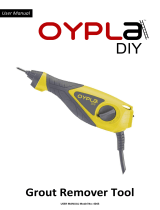
vi
SAFETYVRTEX
®
360
ELECTROMAGNETIC
COMPATABILITY (EMC)
CONFORMANCE
Products displaying the CE mark are in conformity with European
Community Council Directive of 3 May 1989 on the approximation of
the laws of the Member States relating to electromagnetic compat-
ibility (89/336/EEC). It was manufactured in conformity with a national
standard that implements a harmonized standard: EN 60974-10
Electromagnetic Compatibility (EMC) Product Standard for Arc Welding
Equipment. It is for use with other Lincoln Electric equipment. It is
designed for industrial and professional use.
INTRODUCTION
All electrical equipment generates small amounts of electromagnetic
emission. Electrical emission may be transmitted through power lines or
radiated through space, similar to a radio transmitter. When emissions
are received by other equipment, electrical interference may result.
Electrical emissions may affect many kinds of electrical equipment;
other nearby welding equipment, radio and TV reception, numerical
controlled machines, telephone systems, computers, etc. Be aware that
interference may result and extra precautions may be required when a
welding power source is used in a domestic establishment.
INSTALLATION AND USE
The user is responsible for installing and using the welding equipment
according to the manufacturer’s instructions. If electromagnetic
disturbances are detected then it shall be the responsibility of the
user of the welding equipment to resolve the situation with the
technical assistance of the manufacturer. In some cases this remedial
action may be as simple as earthing (grounding) the welding circuit,
see Note. In other cases it could involve construction of an electro-
magnetic screen enclosing the power source and the work complete
with associated input filters. In all cases electromagnetic disturbances
must be reduced to the point where they are no longer troublesome.
Note:
The welding circuit may or may not be earthed for safety reasons accord-
ing to national codes. Changing the earthing arrangements should only be
authorized by a person who is competent to access whether the changes
will increase the risk of injury, e.g., by allowing parallel welding current
return paths which may damage the earth circuits of other equipment.
ASSESSMENT OF AREA
Before installing welding equipment the user shall make an
assessment of potential electromagnetic problems in the surrounding
area. The following shall be taken into account:
a. other supply cables, control cables, signaling and telephone cables;
above, below and adjacent to the welding equipment;
b. radio and television transmitters and receivers;
c. computer and other control equipment;
d. safety critical equipment, e.g., guarding of industrial equipment;
e. the health of the people around, e.g., the use of pacemakers and
hearing aids;
f. equipment used for calibration or measurement
g. the immunity of other equipment in the environment. The user
shall ensure that other equipment being used in the environment is
compatible. This may require additional protection measures;
h. the time of day that welding or other activities are to be carried out.
The size of the surrounding area to be considered will depend on the
structure of the building and other activities that are taking place. The
surrounding area may extend beyond the boundaries of the premises.
METHODS OF REDUCING EMISSIONS
Mains Supply
Welding equipment should be connected to the mains supply
according to the manufacturer’s recommendations. If interference
occurs, it may be necessary to take additional precautions such
as filtering of the mains supply. Consideration should be given
to shielding the supply cable of permanently installed welding
equipment, in metallic conduit or equivalent. Shielding should be
electrically continuous throughout its length. The shielding should be
connected to the welding power source so that good electrical contact
is maintained between the conduit and the welding power source
enclosure.
Maintenance of the Welding Equipment
The welding equipment should be routinely maintained according
to the manufacturer’s recommendations. All access and service
doors and covers should be closed and properly fastened when the
welding equipment is in operation. The welding equipment should not
be modified in any way except for those changes and adjustments
covered in the manufacturers instructio ns. In particular, the spark
gaps of arc striking and stabilizing devices should be adjusted and
maintained according to the manufacturer’s recommendations.
Welding Cables
The welding cables should be kept as short as possible and should be
positioned close together, running at or close to floor level.
Equipotential Bonding
Bonding of all metallic components in the welding installation and
adjacent to it should be considered. However, metallic components
bonded to the work piece will increase the risk that the operator
could receive a shock by touching these metallic components and the
electrode at the same time. The operator should be insulated from all
such bonded metallic components.
Earthing of the Workpiece
Where the workpiece is not bonded to earth for electrical safety, not
connected to earth because of its size and position, e.g., ships hull
or building steelwork, a connection bonding the workpiece to earth
may reduce emissions in some, but not all instances. Care should be
taken to prevent the earthing of the work piece increasing the risk
of injury to users, or damage to other electrical equipment. Where
necessary, the connection of the workpiece to earth should be made
by a direct connection to the work piece, but in some countries where
direct connection is not permitted, the bonding should be achieved by
suitable capacitance, selected according to national regulations.
Screening and Shielding
Selective screening and shielding of other cables and equipment
in the surrounding area may alleviate problems of interference.
Screening of the entire welding installation may be considered for
special applications.
1
Portions of the preceding text are contained in EN 60974-10: “Electromagnetic
Compatibility (EMC) product standard for arc welding equipment.”
























